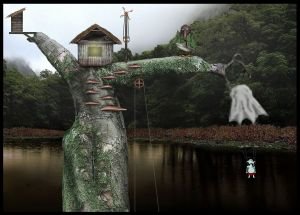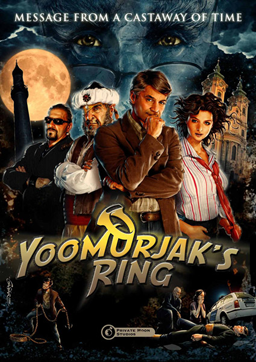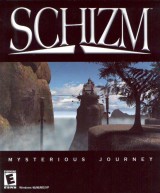Review for Haluz 1 and 2

Without the need for installation and setup procedures, browser-based games can be the perfect choice for players who want to game immediately. While many online games provide very basic casual fare, Amanita Design’s popular Samorost series helped prove that browser-based adventures can also be enjoyable. Following Amanita in more ways than one, the two Haluz games from Springtail Studio provide a similarly fun, if surreal, experience.
In each game you play a small humanoid on a quest for something lost. In the first adventure, this is a satellite dish stolen by a passing bird. In the second, a note dropped by another passing bird leads to a search for a damsel in distress. Apart from the opening and closing scenes, there is little that could be considered a "story" within either game. Both heroes travel by varied means across strange landscapes, facing a series of bizarre and disconnected challenges that ultimately lead to their goal. In fact, in Haluz 2, the protagonist has to make two such journeys, as a giant flings him away on the cusp of success. This is no doubt a result of the game originally being offered partly for free and partly for pay (though now completely free of charge).
Graphically, the Haluz series is very similar to the Samorost games. Colourised photographs of natural elements, such as wood, water and stone, are melded together to form a scenic backdrop, and hand drawn elements have been added to create the characters and interactive environment within this setting. In almost all cases, these additional elements have been coloured and shaded to a level of detail that does not jar with the realistic backdrops, and it’s these that create the surreal atmosphere: A snail has a French Horn for a shell and a Bush Baby hangs from a toadstool that is also a lamp. There are also limited lighting effects in some sections, with bulbs casting a smoothly diminishing glow around them. The main characters and mechanisms are all fully animated, plus there is plenty of background activity. Some of these happen automatically, such as bugs crawling up tree limbs, and some are instigated by the player, like prodding a butterfly to visit a nearby flower. All these are fluid, and the creatures realistically mimic actual movement.
Sound effects are used throughout the games, whether the splashing of water being poured or the cry of a bird. These effects further serve to bring the world alive, and with the exception of a lone Tarzan yell, they fit in well with the look of the game. There is also limited use of music, mainly reserved for scenes showing the protagonists travelling from one location to another but occasionally used in playable sections as well. The music, predominantly involving guitars, forms a gentle audio ambience for the game, but its freeform, almost improvisational style ensured that none of it stuck in my memory. The Haluz games include no spoken dialogue, only random noises to indicate conversation in a handful of scenes.
Control is entirely point-and-click, and being made with Flash, only left-clicking is allowed. Clickable areas are highlighted by the cursor changing when it passes over them. With the exception of switches, which usually require the protagonist to be nearby before you can use them, most of the time you are able to click objects anywhere within the screen, whether the player character can reach them or not. Animals can be prompted into action, machines can be operated, and giant plants pressed into service as lures or trampolines. It is also possible to drag some items, such as the mix of razor blades, eating implements and stationery that line the nest of the bird that stole your satellite dish. It is only possible to drag these objects to other areas of the same screen, as neither game features an inventory. There are a couple of occasions when you have to see a mechanism working before you can perform certain actions. Normally you need to run them to understand what they do anyway, so this is not a major issue. However, anyone who sweeps each new screen for hotspots prior to doing anything else will need to do so again to pick up additional options after operating such equipment.
In keeping with the bizarre landscapes, the puzzles themselves are often quite unorthodox. Crossing a dark chasm involves manipulating a bat, and a baby bird helped me operate a lift in a most unusual fashion. Simply clicking all objects until you find the right order is not always enough to progress. You will often need to time your clicks, either to match a background animation or another player-activated event. There was one instance where I found this mildly frustrating, but the timing is usually fairly generous. There are also a number of machines to fathom, like a ride-in robotic crab, and one case of a cleverly hidden code to discover. There are no irreversible actions, so players are free to experiment with solutions, which should be sufficient for most experienced adventurers. The main difficulty I found was in locating a few of the hotspots, as the detailed graphics make it hard to determine what items you can interact with. This problem is exacerbated by the need to be fairly precise in some of the drag-and-drop puzzles. I can imagine some players abandoning a correct solution simply because they were slightly off in their object placement.
Although the first game’s play time is short enough not to need one, Haluz 2 is about triple the length and features a save system of sorts. This takes the form of passwords presented on each new screen that allow the player to leap to that point. Providing passwords instead of browser cookies also allows a player to pick up in the same place on an entirely different machine. Whilst it should be possible to complete even the sequel in one session, this is a welcome feature for anyone who wishes to take a break.
If you’re a fan of Samorost, it is likely that you’ll appreciate these titles as well, as the look and gameplay are very similar. Both Haluz games are enjoyably surreal adventures which manage to fit a surprising variety of contextual puzzles into their single-click controls. They are also attractive to look at, with gorgeously detailed graphics for a free game. If you aren’t prepared to do some pixel-hunting, you may have problems, but this issue isn’t so pervasive as to be more than a mild irritant for most. Overall, these games are well worth investing the hour or so that the two games combined will take you.


























